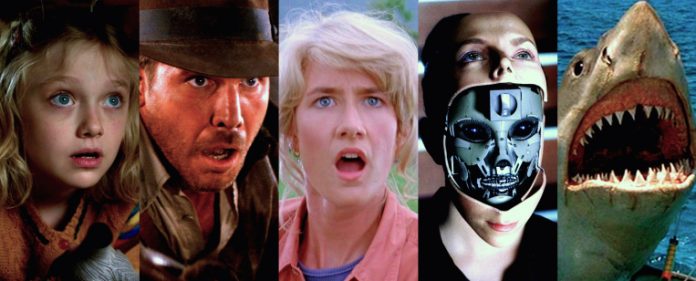You’ve been there: a bright green screen with firm white lettering flashes on the previously dull-white screen, reading “The following preview has been approved for all audiences” and denotes that the feature is rated PG-13. Immediately, you recline in the red, faux leather movie theater seat, naturally curious to see the imminent movie trailer. As expected, dramatic violins, heavy sound effects, distorted robot sounds, and somewhat mediocre acting inundates your senses before you know it. A large, canned voice boomingly announces “THIS SUMMER,” building anticipation for the ‘Blockbuster of the year.’ “WITH EXECUTIVE PRODUCER STEVEN SPIELBERG,” the voice continues, announcing the fifth installment of the Transformers movie series subsequently. Rolling your eyes and shrugging your shoulders while the credits quickly blaze by, you purge the cliché format and contents of the previous trailer from your mind. This type of monotonous trailer seems commonplace and overdone, as though every movie is required to conform to a certain template for promoting and executing the film. The truth is, you may roll your eyes now, but, you’ll soon be sitting at that new Transformers flick, despite your initial recalcitrant attitude, before you know it.
This form of movie is at no shortage in today’s day and age. But consider this: it wasn’t alway like that, was it? At some point, this was a groundbreaking practice in the film industry, just as every overused cliché is considered revolutionary at one point in time.
What film spawned the term ‘Blockbuster’? The Godfather? Star Wars? Valid guesses, but I’d distill it down to one man in particular whom I mentioned before: Steven Allan Spielberg.
Steven Spielberg.
[vimeo 157222602 w=500 h=281]
Well known in his craft for good reason, Spielberg has greatly influenced the modern film industry and has crafted most of the films that are often accredited as being blockbusters today. Winner of three Oscars, three Golden Globes, four Emmys, and many other awards from various sources, the 69-year-old director, producer, and writer has had a hand in almost every premise of modern film today.
In the 70s, Spielberg, in his late twenties, had directed a handful of minor TV shows and movies when he was granted a spot as the director of a thriller-horror film named Jaws. Following the release, “Spielberg” became a household name and he also turned into one of the United States’ youngest multi-millionaires. With this newfound notoriety, Spielberg was offered the director’s chair on tentative films such as Jaws 2, King Kong, and Superman, all three large films awaiting the Spielberg treatment. A guaranteed deal of more money and more notoriety before him, Spielberg politely declined. This is where Spielberg became a visionary and innovator. In lieu of these offers, Spielberg called upon actor Richard Dreyfuss and began work on an experimental film about Unidentified Flying Objects, a film now known as Close Encounters of the Third Kind. He was nominated for Best Director and won six other Academy Awards that year alone.
Spielberg flourished in the 80s and 90s. Helping create hits ranging from Indiana Jones: Raiders of the Lost Ark to E.T. to The Color Purple and all the way to Empire of the Sun amongst others in the 1980s. In the 90s, Spielberg’s hand was present in fantastic flicks like Jurassic Park, Schindler’s List, and Saving Private Ryan. Truly, this was his defining slew of works, all of which have grown into the aesthetic of the average American moviegoer.
To see a full list of films he’s credited on, see the IMDB site.
Jon Birondo ’15, a film student at the University of North Texas and cinema enthusiast, finds Spielberg as a particularly noteworthy visionary in film history. He explains: “For me, Spielberg was the first filmmaker I ever noticed a particular style in. His ideas were so simple, but the way he crafted and translated these stories onto film transcended the words on the paper. However, his trademark is rather elusive for it isn’t something blatant (such as Wes Anderson’s use of symmetry or J.J Abrams’ use of lens flares); it’s mainly a certain feeling he conveys when the images, dialogue, and music all coalesce on screen. There are certain recurrences like strained relationships with fathers and the importance of childhood, but Spielberg’s films go beyond these simple themes in the best way.” Picking favorites from the buffet of blockbusters, Birondo notes “Spielberg film… Empire of The Sun; I can’t express how much joy I felt when watching the film for the first time. Perhaps was, and will be the only time I’ll be exuberant during a war movie.”
A student himself, Birondo sees that budding filmmakers can “learn from Spielberg the importance of music, how to develop a compelling character, and how to compose a shot. For example, Jaws (a classic, obviously). The movie would be nowhere without its iconic theme.” He continues, “All the characters have their respective back stories, which helps the audience empathize with them better. One scene, when the crew sings in the boat at night, may come off as goofy and aloof but it helps develop their camaraderie in order gain some empathy. Lastly, shot composition; a lot of Spielberg’s films have some of the most iconic images in film. From E.T. to The Color Purple to Schindler’s List – these images have made their mark in the canon of cinema.”
Technologically, Spielberg has remained an innovator in a multitude of fields, allowing him to bestow a signature touch to all. In terms of animation, Spielberg co-founded Dreamworks, a renouned animation studio, and embraced CGI as a valuable tool. Before Jurassic Park, most CGI development was shabby, to say the least. Instead of defaulting to puppets (E.T., Star Wars: Episode I The Phantom Menace), Spielberg gave graphics made for the big screen that audiences could really sink their teeth into.
The mark of Spielberg on modern cinema along with history is unmistakable. His vision and relentless innovation has and will inspire many for decades to come, and will remain at the forefront of entertainment for many more years to come.






